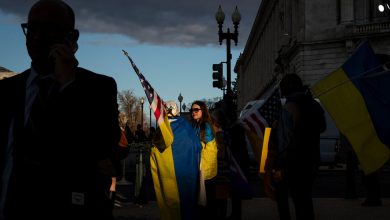A Botched Drone Strike in Kabul Started With the Wrong Car

WASHINGTON — U.S. military officials have insisted since the last American troops withdrew from Afghanistan last month that they would be able to detect and attack Islamic State or Qaeda threats in the country from afar.
But an errant drone strike that killed 10 civilians, including seven children, in Kabul on Aug. 29 calls into question the reliability of the intelligence that will be used to conduct the operations.
U.S. commanders concede that the missions will be more difficult without a military presence in the country. But new details about the drone strike, which the Pentagon initially said was necessary to prevent an attack on American troops, show the limitations of such counterterrorism missions even when U.S. forces are on the ground.
“The U.S. has a terrible record in this regard, and after decades of failed accountability, in the context of the end of the war in Afghanistan, the U.S. should acknowledge that their processes have failed, and that vital reforms and more independent outside scrutiny is vital,” John Sifton, the Asia advocacy director at Human Rights Watch, said in an email.
Thirty-six hours before the strike, intelligence analysts and drone operators at a base in Qatar were sifting through more than 60 specific pieces of intelligence — some conflicting, some mutually reinforcing — related to an imminent ISIS attack, according to Gen. Kenneth F. McKenzie Jr., the commander of the military’s Central Command.
The group, called the Over-the-Horizon Strike Cell, was created in early July to track and disrupt plots in Afghanistan by Al Qaeda or the Islamic State that threatened the U.S. homeland. After the sudden Taliban takeover of the country, the cell began focusing on ISIS threats against the thousands of American troops at Hamid Karzai International Airport in Kabul who were helping tens of thousands of Afghans flee the country.
On the morning of Aug. 29, the military was on high alert, looking out for a white Toyota Corolla as six Reaper drones monitored what General McKenzie called a suspected Islamic State compound, or safe house, both believed to be linked to the plot.
The strike cell commander kept in close contact with Maj. Gen. Christopher Donahue, the head of the 82nd Airborne Division and the ground force commander at the airport. General McKenzie was also kept apprised of the developments during the day.
Just before 9 o’clock, Zemari Ahmadi, a longtime worker for a U.S. aid group, wheeled his white 1996 Toyota Corolla in front of the safe house the Americans were watching. Two men got out of the car, met with another man at the safe house, took a bag from him and returned to the car. Mr. Ahmadi drove off.
Eight hours later, a Hellfire missile slammed into the sedan, killing Mr. Ahmadi and nine other people in what American officials now acknowledge was a tragic case of mistaken identity.
“Clearly our intelligence was wrong on this particular white Toyota Corolla,” General McKenzie told reporters on Friday. “We thought this was a good lead. We were wrong.”
Military officials have declined to release the strike cell commander’s name, rank or organization, but say he is an experienced operator who has carried out drone strikes in multiple theaters.
The strike against a white Toyota believed to be carrying explosives was launched, General McKenzie said, “in the profound belief” that Islamic State Khorasan, or ISIS-K, was about to attack the airport, as the terrorist group had done three days earlier, killing more than 140 people, including 13 American service members.
“This was not a rushed strike,” the general said. “The strike cell deliberately followed and observed this vehicle and its occupants for eight hours while crosschecking what they were seeing with all available intelligence to develop a reasonable certainty of the imminent threat that this vehicle posed to our forces.”
In his Pentagon news conference, General McKenzie sought to explain the context in which the drone strike commander and his team made their decision, ultimately with the approval of General Donahue, the ground commander and one of the most storied operators of his generation with 17 deployments to Afghanistan, Iraq, Syria and North Africa in a nearly 30-year career.
Two days before the drone strike, the military determined through electronic intercepts, informants and aerial surveillance that ISIS planners were using a compound about three miles northwest of the airport to facilitate future attacks with rockets, suicide explosive vests and car bombs.
One recurring aspect of the intelligence, General McKenzie said, was that ISIS would use a white Toyota Corolla as a key element in the next attack against American troops at the airport.
After the suspected ISIS safe house emerged as the strongest lead in the feared attacks, the military assigned as many as six MQ-9 Reaper drones to monitor it on the morning of Aug. 29.
At 8:52 a.m., a white Toyota Corolla — Mr. Ahmadi’s sedan — arrived at the compound, the military said, and the package exchange occurred.
But witness testimony and visual evidence gathered by The New York Times indicate that this compound was most likely the home of Mr. Ahmadi’s boss, the country director of Nutrition and Education International, a California-based aid group.
The director had asked Mr. Ahmadi to stop by his home to pick up his laptop on the way to work that morning. The director has denied any ties to ISIS. A senior American military official said analysts are now exploring the possibility that the ISIS safe house was actually a neighboring house.
From that point on, however, Mr. Ahmadi’s sedan became the military’s primary suspect in the plot.
Military analysts seized on other movements by Mr. Ahmadi as he drove around Kabul to reinforce their judgment. At 11:19 a.m., at least two men unloaded jugs from the trunk of the sedan at another compound, which the military now says was the aid organization’s headquarters. But at the time, commanders did not know that. They received intelligence reports at the time that an ISIS cell leader in Kabul was dropping off supplies.
After other errands, the Toyota Corolla returned to the aid organization’s headquarters and analysts observed men loading into the trunk what the Americans believed were explosives before the sedan left at 3:47 p.m. The military’s investigation later determined the packages were probably water canisters.
It was just before 5 p.m. when the white sedan made its final stop — in a courtyard off a busy street about two miles from the airport. General McKenzie said the “cumulative force” of the information the military had collected throughout the day — the vehicle’s earlier stop at the suspected ISIS compound, the loading into the car of what analysts believed were explosives and the proximity of the car to airport — was damning.
“To the strike cell, this all added up,” he said.
At this point, the strike cell commander controlling the armed Reaper drones had to make a quick decision. His authority to strike had been delegated by General McKenzie several days earlier.
The rules of engagement allowed the military to conduct a strike if the operators and intelligence analysts had “reasonable certainty” that they had a legitimate ISIS target and assessed there was a “reasonable certainty” that no noncombatant civilians, including women and children, would be killed or injured. General McKenzie said the commander believed that standard was met, and the general said he agreed at the time with that judgment.
Understand the Taliban Takeover in Afghanistan
Who are the Taliban? The Taliban arose in 1994 amid the turmoil that came after the withdrawal of Soviet forces from Afghanistan in 1989. They used brutal public punishments, including floggings, amputations and mass executions, to enforce their rules. Here’s more on their origin story and their record as rulers.
Who are the Taliban leaders? These are the top leaders of the Taliban, men who have spent years on the run, in hiding, in jail and dodging American drones. Little is known about them or how they plan to govern, including whether they will be as tolerant as they claim to be. One spokesman told The Times that the group wanted to forget its past, but that there would be some restrictions.
How did the Taliban gain control? See how the Taliban retook power in Afghanistan in a few months, and read about how their strategy enabled them to do so.
What happens to the women of Afghanistan? The last time the Taliban were in power, they barred women and girls from taking most jobs or going to school. Afghan women have made many gains since the Taliban were toppled, but now they fear that ground may be lost. Taliban officials are trying to reassure women that things will be different, but there are signs that, at least in some areas, they have begun to reimpose the old order.
What does their victory mean for terrorist groups? The United States invaded Afghanistan 20 years ago in response to terrorism, and many worry that Al Qaeda and other radical groups will again find safe haven there. On Aug. 26, deadly explosions outside Afghanistan’s main airport claimed by the Islamic State demonstrated that terrorists remain a threat.
How will this affect future U.S. policy in the region? Washington and the Taliban may spend years pulled between cooperation and conflict, Some of the key issues at hand include: how to cooperate against a mutual enemy, the Islamic State branch in the region, known as ISIS-K, and whether the U.S. should release $9.4 billion in Afghan government currency reserves that are frozen in the country.
The drone operators took a few minutes to scan the close confines of the courtyard and saw only the one other man talking to the driver. The commander and his team concluded this was the best time and place to take the shot. If the Americans waited and the vehicle wove through busy city traffic or approached the airport, the risk to civilians would be much greater — either from a drone strike or the detonation of suicide vests or a huge car bomb.
transcript
How a U.S. Drone Strike Killed the Wrong Person
A week after a New York Times visual investigation, the U.S. military admitted to a “tragic mistake” in a drone strike in Kabul last month that killed 10 civilians, including an aid worker and seven children.
[explosion] In one of the final acts of its 20-year war in Afghanistan, the United States fired a missile from a drone at a car in Kabul. It was parked in the courtyard of a home, and the explosion killed 10 people, including 43-year-old Zemari Ahmadi and seven children, according to his family. The Pentagon claimed that Ahmadi was a facilitator for the Islamic State, and that his car was packed with explosives, posing an imminent threat to U.S. troops guarding the evacuation at the Kabul airport. “The procedures were correctly followed, and it was a righteous strike.” What the military apparently didn’t know was that Ahmadi was a longtime aid worker, who colleagues and family members said spent the hours before he died running office errands, and ended his day by pulling up to his house. Soon after, his Toyota was hit with a 20-pound Hellfire missile. What was interpreted as the suspicious moves of a terrorist may have just been an average day in his life. And it’s possible that what the military saw Ahmadi loading into his car were water canisters he was bringing home to his family — not explosives. Using never-before seen security camera footage of Ahmadi, interviews with his family, co-workers and witnesses, we will piece together for the first time his movements in the hours before he was killed. Zemari Ahmadi was an electrical engineer by training. For 14 years, he had worked for the Kabul office of Nutrition and Education International. “NEI established a total of 11 soybean processing plants in Afghanistan.” It’s a California based NGO that fights malnutrition. On most days, he drove one of the company’s white Toyota corollas, taking his colleagues to and from work and distributing the NGO’s food to Afghans displaced by the war. Only three days before Ahmadi was killed, 13 U.S. troops and more than 170 Afghan civilians died in an Islamic State suicide attack at the airport. The military had given lower-level commanders the authority to order airstrikes earlier in the evacuation, and they were bracing for what they feared was another imminent attack. To reconstruct Ahmadi’s movements on Aug. 29, in the hours before he was killed, The Times pieced together the security camera footage from his office, with interviews with more than a dozen of Ahmadi’s colleagues and family members. Ahmadi appears to have left his home around 9 a.m. He then picked up a colleague and his boss’s laptop near his house. It’s around this time that the U.S. military claimed it observed a white sedan leaving an alleged Islamic State safehouse, around five kilometers northwest of the airport. That’s why the U.S. military said they tracked Ahmadi’s Corolla that day. They also said they intercepted communications from the safehouse, instructing the car to make several stops. But every colleague who rode with Ahmadi that day said what the military interpreted as a series of suspicious moves was just a typical day in his life. After Ahmadi picked up another colleague, the three stopped to get breakfast, and at 9:35 a.m., they arrived at the N.G.O.’s office. Later that morning, Ahmadi drove some of his co-workers to a Taliban-occupied police station to get permission for future food distribution at a new displacement camp. At around 2 p.m., Ahmadi and his colleagues returned to the office. The security camera footage we obtained from the office is crucial to understanding what happens next. The camera’s timestamp is off, but we went to the office and verified the time. We also matched an exact scene from the footage with a timestamp satellite image to confirm it was accurate. A 2:35 p.m., Ahmadi pulls out a hose, and then he and a co-worker fill empty containers with water. Earlier that morning, we saw Ahmadi bring these same empty plastic containers to the office. There was a water shortage in his neighborhood, his family said, so he regularly brought water home from the office. At around 3:38 p.m., a colleague moves Ahmadi’s car further into the driveway. A senior U.S. official told us that at roughly the same time, the military saw Ahmadi’s car pull into an unknown compound 8 to 12 kilometers southwest of the airport. That overlaps with the location of the NGO’s office, which we believe is what the military called an unknown compound. With the workday ending, an employee switched off the office generator and the feed from the camera ends. We don’t have footage of the moments that followed. But it’s at this time, the military said that its drone feed showed four men gingerly loading wrapped packages into the car. Officials said they couldn’t tell what was inside them. This footage from earlier in the day shows what the men said they were carrying — their laptops one in a plastic shopping bag. And the only things in the trunk, Ahmadi’s co-workers said, were the water containers. Ahmadi dropped each one of them off, then drove to his home in a dense neighborhood near the airport. He backed into the home’s small courtyard. Children surrounded the car, according to his brother. A U.S. official said the military feared the car would leave again, and go into an even more crowded street or to the airport itself. The drone operators, who hadn’t been watching Ahmadi’s home at all that day, quickly scanned the courtyard and said they saw only one adult male talking to the driver and no children. They decided this was the moment to strike. A U.S. official told us that the strike on Ahmadi’s car was conducted by an MQ-9 Reaper drone that fired a single Hellfire missile with a 20-pound warhead. We found remnants of the missile, which experts said matched a Hellfire at the scene of the attack. In the days after the attack, the Pentagon repeatedly claimed that the missile strike set off other explosions, and that these likely killed the civilians in the courtyard. “Significant secondary explosions from the targeted vehicle indicated the presence of a substantial amount of explosive material.” “Because there were secondary explosions, there’s a reasonable conclusion to be made that there was explosives in that vehicle.” But a senior military official later told us that it was only possible to probable that explosives in the car caused another blast. We gathered photos and videos of the scene taken by journalists and visited the courtyard multiple times. We shared the evidence with three weapons experts who said the damage was consistent with the impact of a Hellfire missile. They pointed to the small crater beneath Ahmadi’s car and the damage from the metal fragments of the warhead. This plastic melted as a result of a car fire triggered by the missile strike. All three experts also pointed out what was missing: any evidence of the large secondary explosions described by the Pentagon. No collapsed or blown-out walls, including next to the trunk with the alleged explosives. No sign that a second car parked in the courtyard was overturned by a large blast. No destroyed vegetation. All of this matches what eyewitnesses told us, that a single missile exploded and triggered a large fire. There is one final detail visible in the wreckage: containers identical to the ones that Ahmadi and his colleague filled with water and loaded into his trunk before heading home. Even though the military said the drone team watched the car for eight hours that day, a senior official also said they weren’t aware of any water containers. The Pentagon has not provided The Times with evidence of explosives in Ahmadi’s vehicle or shared what they say is the intelligence that linked him to the Islamic State. But the morning after the U.S. killed Ahmadi, the Islamic State did launch rockets at the airport from a residential area Ahmadi had driven through the previous day. And the vehicle they used … … was a white Toyota. The U.S. military has so far acknowledged only three civilian deaths from its strike, and says there is an investigation underway. They have also admitted to knowing nothing about Ahmadi before killing him, leading them to interpret the work of an engineer at a U.S. NGO as that of an Islamic State terrorist. Four days before Ahmadi was killed, his employer had applied for his family to receive refugee resettlement in the United States. At the time of the strike, they were still awaiting approval. Looking to the U.S. for protection, they instead became some of the last victims in America’s longest war. “Hi, I’m Evan, one of the producers on this story. Our latest visual investigation began with word on social media of an explosion near Kabul airport. It turned out that this was a U.S. drone strike, one of the final acts in the 20-year war in Afghanistan. Our goal was to fill in the gaps in the Pentagon’s version of events. We analyzed exclusive security camera footage, and combined it with eyewitness accounts and expert analysis of the strike aftermath. You can see more of our investigations by signing up for our newsletter.”

A week after a New York Times visual investigation, the U.S. military admitted to a “tragic mistake” in a drone strike in Kabul last month that killed 10 civilians, including an aid worker and seven children.CreditCredit…By The New York Times. Video frame: Nutrition & Education International.
General Donahue, the ground force commander, concurred after asking several questions to validate the attack, a Defense Department official said, and the Hellfire missile struck its target in less than a minute. Seconds after the missile was launched, the drone operators could see on the grainy live-video feed that other figures — most likely children — were approaching the sedan. But it was too late to stop the strike.
“It was a mistake, and I offer my sincere apology,” General McKenzie said on Friday.
He said future American airstrikes in Afghanistan would be different from the one taken on Aug. 29. They would be what the military calls deliberate strikes, which he said would be subject to more stringent rules of engagement with more time to monitor a potential target, plan an attack and assess the risk to civilians, a process the military calls establishing “a pattern of life.”
“We did not have the luxury of time to develop pattern of life and to do a number of other things,” General McKenzie said of the Aug. 29 missile attack. “I don’t think you should draw any conclusions about our ability to strike in Afghanistan against ISIS-K targets in the future based on this particular strike.”
But other military experts are calling for an overhaul of the procedures the military uses to identify targets and carry out drone strikes.
“You never want to judge too much from a single incident, but the way they bungled fundamental operational things is really troubling and suggests more than a one-off mistake,” Luke Hartig, who worked on drone strike policy for the Obama administration as a senior director for counterterrorism at the National Security Council, said in a Twitter post on Friday.
“Its interpretation of an innocent man’s set of movements as those of a terrorist or an attack facilitator show some massive flaws in targeting methodology,” Mr. Hartig said.
Other experts have warned that the military has failed to focus on fixing errors in identifying a target — the crucial initial analytic flaw in the Aug. 29 strike.
A 2018 study on civilian casualties ordered by the chairman of the Joint Chiefs of Staff concluded that there was “sufficient guidance and structure” in the targeting process, which did not increase the risk of civilian casualties. But two members of the study team — Lawrence L. Lewis and Sarah Holewinski, civilian casualty specialists — disagreed with the report’s conclusions and urged more research on the issue.
“I just wish we could start fixing these problems instead of writing them off as ‘mistakes,’” Mr. Lewis said in an email.
Defense Secretary Lloyd J. Austin III has ordered a review of the Central Command’s inquiry into the drone strike to determine, among other issues, who should be held accountable and “the degree to which strike authorities, procedures and processes need to be altered in the future.”
On Monday, John F. Kirby, the chief Pentagon spokesman, said that Mr. Austin had directed the Air Force to select a senior general to conduct the review, to be completed within 45 days. The Air Force said on Tuesday that it had assigned Lt. Gen. Sami D. Said, the Air Force inspector general, to the task. An experienced F-15 and F-16 fighter pilot, General Said served as a senior staff officer in Afghanistan in 2013 and 2014.
Meantime, Mr. Austin, a retired four-star Army general, has ordered that any further airstrikes in Afghanistan receive his approval.
Members of Congress from both parties have called for hearings into the drone strike.
“There must be accountability,” Senator Christopher S. Murphy, a Connecticut Democrat on the Foreign Relations Committee, said in a Twitter post on Friday. “If there are no consequences for a strike this disastrous, it signals to the entire drone program chain of command that killing kids and civilians will be tolerated.”





